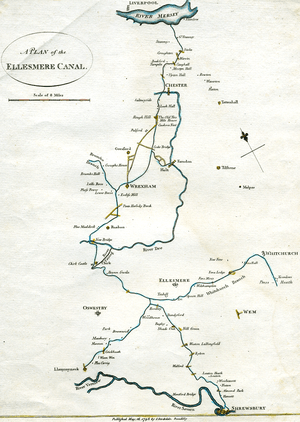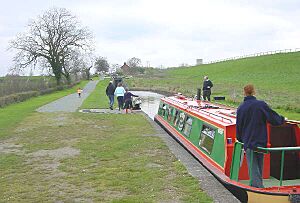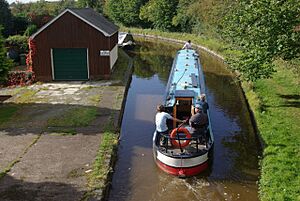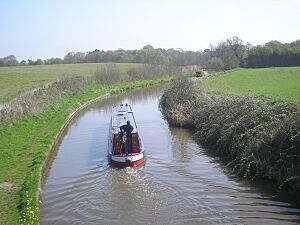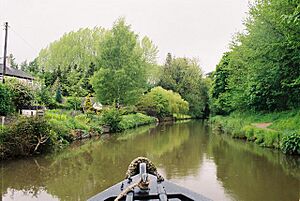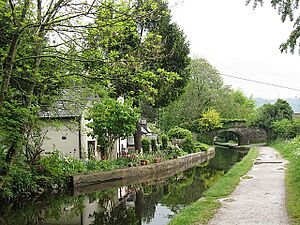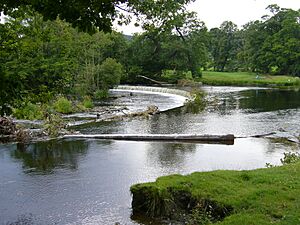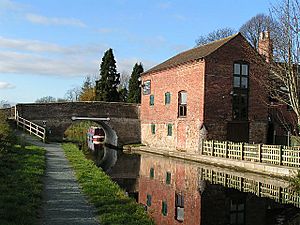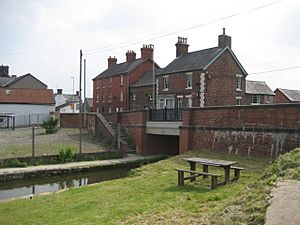Ellesmere Canal facts for kids

The Ellesmere Canal was a special waterway in England and Wales. It was planned to connect two big rivers, the Mersey and the Severn. The idea was to link the busy Port of Liverpool with the mining areas in north east Wales and the factories in the West Midlands. However, this huge canal was never fully finished because it cost too much money and didn't bring in as much boat traffic as people hoped.
The Ellesmere Canal was first suggested in 1791. It was meant to run from Netherpool in Cheshire all the way to Shrewsbury. But only some parts were built. These parts later became sections of the Chester Canal, Montgomery Canal, and Shropshire Union Canal. Even though engineers built some amazing structures, like the Pontcysyllte Aqueduct, major building work stopped in 1805. The northern end of the canal ended about 15 miles (25 km) from Chester at Trevor Basin near Ruabon. Its southern end was at Weston Lullingfields, about 9 miles (15 km) from Shrewsbury.
Today, the main part of the canal that still exists is called the Llangollen Canal. This is a bit funny because the original builders never planned for boats to go to Llangollen! The part of the canal that now gives it its name was actually built to bring water from the River Dee to the main canal. This is why it was built as a narrow canal, not a wide one.
History of the Ellesmere Canal
Planning the Canal Route
The idea for the Ellesmere Canal officially started at a meeting in Ellesmere in 1791. The plan was to build a canal from Netherpool (now Ellesmere Port) on the River Mersey to the River Dee at Chester. From there, it would go southeast through Overton (south of Wrexham) to the River Severn at Shrewsbury. Smaller branches would also be built to reach iron and coal mining areas at Bersham and Llanymynech. By 1793, a special law called an Act of Parliament was passed, allowing the Ellesmere Canal company to start building.
However, not everyone agreed on the best route for the canal after Chester. Some supporters wanted it to go further west, directly through the Welsh mining areas. This western route was eventually chosen after engineer John Duncombe surveyed it. Famous engineer William Jessop was asked for his advice, and he also recommended Duncombe's western route. Jessop became the main engineer for the project, and Thomas Telford was hired as the General Agent. The first part of the canal, from the Mersey to the Dee, was finished in 1797. This allowed the company to start collecting money from tolls, which helped pay for the rest of the canal.
The western route, however, had big challenges. Near the Eglwyseg and Ruabon mountains, there were deep river valleys to cross and high ground that needed tunnels. Duncombe's plan included climbing 303 feet (92 m) from Chester to Wrexham, a 4,607-yard (4,213 m) tunnel at Ruabon, a very high crossing over the Dee at Pontcysyllte, another tunnel and aqueduct near Chirk, and a tunnel in Shropshire near Weston Lullingfields.
A map of the canal from 1795 showed the route from Netherpool in the north to Shrewsbury in the south. It also showed four planned branches:
- A 3-mile (5 km) branch to Holt.
- A 5-mile (8 km) branch from near Wrexham to Brymbo.
- A branch from near Hordley to Llanymynech.
- A 17-mile (27 km) branch from near Tetchill to Prees Heath.
Originally, Jessop thought it would be cheaper to use locks to lower the canal into the Vale of Llangollen and then pump water back up. But by 1795, Jessop and Telford changed their minds. They decided to build a huge aqueduct made of cast-iron to keep the canal at a high level.
Building the Canal
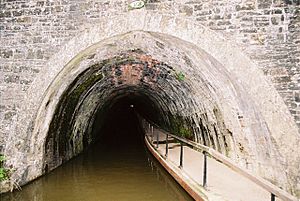
In 1796, the Llanymynech Branch opened. It connected the main canal line at Frankton Junction with Llanymynech. This branch then joined the Montgomeryshire Canal in 1797.
In 1796, Thomas Telford built a special lake in Moss Valley, Wrexham to supply water to the canal section between Trevor Basin and Chester. However, this part of the canal was cancelled in 1798. So, the isolated lake and a short canal section near Ffrwd were abandoned. You can still see parts of the old water channel in Gwersyllt. A street there is even called Heol Camlas (Canal Way).
The section of the canal from the River Mersey to the River Dee at Chester was connected to the Chester Canal in 1797.
On the main line, the Chirk Aqueduct opened in 1801, and the famous Pontcysyllte Aqueduct opened in 1805. But by this time, the plan to extend the canal from the Dee at Chester to Ruabon was dropped because it was too expensive. So, the canal ended at Trevor Basin, about 2 miles (3 km) southwest of Ruabon.
The plan to reach the River Severn was also abandoned. This was because the Shrewsbury Canal already served Shrewsbury, and the River Severn itself wasn't easy to navigate. The extra boat traffic wouldn't make up for the high building costs.
Since the canal wouldn't reach its planned water source northwest of Wrexham, a new water channel was built. This channel ran along the side of the Dee valley to Horseshoe Falls at Llantysilio. This narrow channel was made wide enough for boats, allowing them to reach Llangollen.
In the end, only a few parts of the main Ellesmere Canal were built. These were the far northern section from the Mersey to Chester, and the 18-mile (29 km) central section from Trevor Basin to Weston Lullingfields. Because the middle part was cut off from the rest of Britain's waterways, the planned Whitchurch branch was changed. A 29-mile (47 km) link was built from Frankton, through Ellesmere, to the Chester Canal at Hurleston Junction. This was built in sections between 1797 and 1806. Even though it was a longer, roundabout route, it became known as the main line. This extension also included a small arm to Whitchurch because the town was bypassed by the new route.
A branch was also planned to reach Prees in Shropshire. However, this line was only built as far as Quina Brook, about 1.5 miles (2.4 km) from the village.
The section from Frankton Junction to Weston Lullingfields was originally meant to be the main route to Shrewsbury. It became known as the Weston Branch. The unfinished part between Weston Lullingfields and the River Severn would have been 9.5 miles (15 km) long, with 107 feet (33 m) of locks and a 487-yard (445 m) tunnel at Weston Lullingfields.
The Canal in Use
Because the Ellesmere Canal was never fully completed, it struggled financially as an industrial waterway. In 1813, the Ellesmere Canal company joined with the Chester Canal to form a new company. This new company then merged with another canal company in 1845. A year later, the canal was taken over again by a railway and canal company.
By 1917, the Weston Branch closed after a break in the canal near Hordley Wharf. By 1939, boat traffic on the line from Hurleston to Llangollen had almost stopped. All remaining parts of the Ellesmere Canal, except the northern line from Ellesmere Port to Chester, were officially closed to boats by a law in 1944. However, the canal from Hurleston to Llangollen was kept open to supply water to the main Shropshire Union Canal and for drinking water. In 1955, an agreement with a water board secured the canal's future.
The Canal Today
Even though it was officially closed, more and more people started using the canal for fun boat trips. This led to it being recognized as an important place for recreation. It was then renamed the Llangollen Canal. This new name is a bit funny because the canal was never meant to go to Llangollen! It shows how complicated the canal's history was.
The Ellesmere Canal south of Frankton Junction (the Llanymynech Branch) is now part of the Montgomery Canal. The isolated northern section from Chester to Ellesmere Port is now considered part of the main Shropshire Union Canal.
The Weston Branch is now mostly filled in, except for a very short part that has a Canal & River Trust building for visitors.
Canal Route Sections
Ellesmere Port to Chester
The canal starts at Ellesmere Port Dock by the Mersey River. In the past, goods were moved directly from canal boats to river boats here. But in the 1890s, when the Manchester Ship Canal was built, the dock became separated from the river. Boats now use two sets of locks to move between levels.
A special type of canal, called a contour canal, runs between Ellesmere Port and Chester. It follows the path of a natural river valley. The canal enters Chester Basin (a wharf) where it meets the Chester Canal. Here, there was also a branch with four locks that once led down to the River Dee and the Port of Chester.
When the Ellesmere Canal connected to the Chester Canal, the locks at Chester were changed. The original five-lock staircase was replaced by a deeper three-lock system. This section is now part of the Shropshire Union Canal.
Hurleston to Frankton Junction
This part was added to connect the canal to the larger canal network in Britain. It became the Ellesmere Branch of the Shropshire Union Canal and is now part of the Llangollen Canal.
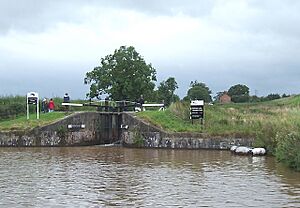

Frankton Junction to Trevor Basin
This was the main part of the original canal line. It became the Llangollen Branch of the Shropshire Union Canal and is now part of the Llangollen Canal.

Trevor Basin to Horseshoe Falls
This part of the canal was added to bring water to the main canal. It is now part of the Llangollen Canal.
Frankton Junction to Llanymynech
This section, called the Llanymynech Branch, is now part of the Montgomery Canal. The section from Frankton Junction to the Weston Branch was originally meant to be the main canal line. The bridges on this canal (which start numbering at Hurleston Junction) continue down the Llanymynech Branch. Even though they are now seen as two separate canals (Llangollen and Montgomery), the bridge numbering stays the same.
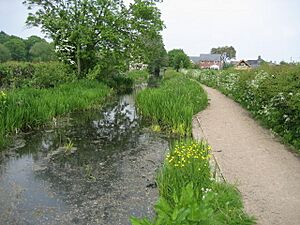
Frankton Junction to Weston Lullingfields

This section was originally planned to be the main line of the canal, but it is now filled in. This 5.5-mile (9 km) long branch had wharves (places for loading and unloading boats) at Hordley, Dandyford, Pedlar's Bridge, Shade Oak, and Weston Lullingfields. At Weston Lullingfields, the canal company built a wharf, four lime kilns (for making lime), a pub, stables, a clerk's house, and a weighing machine. These opened in 1797 and closed in 1917 when the Weston branch was shut down after a break in the canal.


